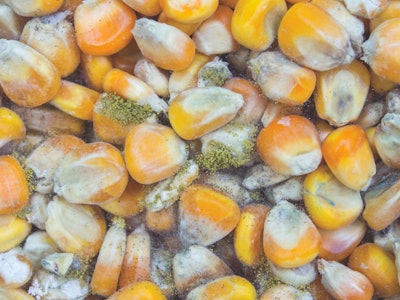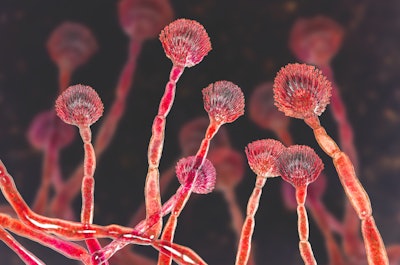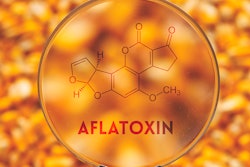
As global warming increases mycotoxin prevalence, researchers say work on solutions is lagging.
Just as soon as science began to get a handle on identifying and controlling mycotoxins, climate change may be changing the game.
Mycotoxins already contaminate the majority of the world’s grains; as many as 89% to 98% of the samples collected for BIOMIN’s annual mycotoxins survey test positive for at least one mycotoxin in wet years.
While warming temperatures and extreme weather driven by climate change intuitively stand to increase the prevalence of mycotoxins in general, there may be little room for the sheer frequency of contamination to increase, according to Raj Murugesan, technical officer, BIOMIN America.
Patterns of mycotoxin contamination are already shifting, and scientists are still cataloging new fungal toxins and their impact on animal health. Research into potential solutions, Murugesan and academics agree, is lagging behind the need for technologies to mitigate mycotoxins.
Many academics, Murugesan said, have limited knowledge of mycotoxins, even in a general sense.
“I don’t think those people have any awareness that this is going on,” he said. “And when you try to educate them, and they don’t understand it — it’s ‘fu-fu science.’”
Growing concern
While it would be difficult for the prevalence of mycotoxins to increase above current conditions, climate change is altering the pattern in what kinds of mycotoxins appear in grains and in what number.
One key trend Murugesan is watching is the percentage of grain contaminated with more than one mycotoxin. In 2012 and 2013, he said, just 20% of samples tested positive for more than one toxin. In 2014, 37% tested positive for more than one; in 2015, the percentage rose to 47%.
Concentrations of mycotoxins have also increased in grains in recent years, though the pattern isn’t steady, Murugesan said. Counts will increase one year, fall the next and increase again, but a gradual trend is present: “The thing is, when it goes down and then goes up, it goes higher,” he said, setting new precedents.
Due to limited data, it’s difficult to say just how long this trend has existed, but Murugesan and other researchers believe a potential causal link points to climate change.
Climate change’s contribution
The fungi that produce mycotoxins generally follow two key conditions: heat and humidity.
BIOMIN’s mycotoxin “heat map,” for example, typically forms a bullseye around the Great Lakes region in the U.S., with mycotoxin concentrations decreasing as samples are collected further west and north. Rising temperatures and increased flooding in areas where these are not historical norms have increased the range of some common mycotoxins, including aflatoxin.
However, heat and moisture aren’t the only factors that can contribute to the production of mycotoxins. Some toxins, for example, are produced when plants and fungi are under stress — conditions that can also be triggered by drought or sudden temperature swings.
Spikes in mycotoxins during droughts, Murugesan said, mirror those that occur during floods.
 Mycotoxin research is growing in popularity, but the discovery of control and mitigation methods is lagging. (Dr_Microbe | iStock.com)
Mycotoxin research is growing in popularity, but the discovery of control and mitigation methods is lagging. (Dr_Microbe | iStock.com)Rise in less-common mycotoxins
The range of less-common mycotoxins has expanded alongside their better-known counterparts, and new mycotoxins are also emerging, though it is difficult to tease out how common these newly discovered toxins were in the past when scientists were unable to detect them.
“We’re learning new things about these compounds and their effects on animals every day it seems, every week,” said Natacha Hogan, an associate professor in the Department of Animal and Poultry Science at the University of Saskatchewan. “With new analytical technology, we’re able to uncover and measure mycotoxins that we couldn’t a month or a year ago.”
Emerging research has changed the way scientists think about certain mycotoxins. Fumonisins, for example, were not considered much of a threat because pigs and especially poultry absorb so little of the toxins.
“That was what we always thought,” said Todd Applegate, a professor in the University of Georgia’s Department of Poultry Science. “Because absorption is very low, they must not confer any real effect on the animal.”
More recent work, including some of his own, suggests these toxins have a more subtle impact on animals, making animals more susceptible to infection. Deoxynivalenol, which is increasingly common in cooler climates, has a similar effect.
These findings are especially concerning, Applegate said, because the spread of mycotoxins has coincided with increased consumer demand for antibiotic-free animal production.
Research also increasingly points to a sort of cumulative effect among many mycotoxins when an animal is exposed to more than one compound simultaneously. Two combined toxins, Hogan said, may often have a greater impact on an animal’s health than either toxin would have on its own.
In her work, Hogan said: “Any time a study is using naturally contaminated feed rather than feed spiked with one mycotoxin, you’re bound to have more than one mycotoxin in there. Anyone who tests their feed … is going to find more than one mycotoxin. And when you have a mixture of mycotoxins, often what you will have is exacerbated or increased effects on target tissues and organ systems.”
Search for solutions
While research regarding specific mycotoxins and their health effects is growing in popularity, the number of scientists knowledgeable of the subject remains small, Applegate said. And research into methods of controlling or mitigating mycotoxins is lagging behind the need for them, Hogan said.
“Is identifying every single mycotoxin going to improve the problem?” she asked. “I would say the focus could be spent on technologies in feed processing in particular that can eliminate poor-quality grain that is associated with whole hosts of mycotoxins, and that will improve the safety of grain that goes into feed processing.”
Such technology does exist in laboratory settings but scaling the process to such a size that it could be used in a commercial feed mill has proven challenging, Hogan said.
The bulk of the work on mycotoxin mitigation has focused on binding agents and, to a lesser degree, on enzymes that can break down toxic compounds, Murugesan said. These products have proven popular for their efficacy with common mycotoxins, especially aflatoxin, and there are several new options about to come on the market.
Nevertheless, producers may not realize that less common mycotoxins — the ones that are currently spreading — aren’t so easily bound by the products available today, Applegate said.
Enzymes might be one of the best alternatives, he said, but those require additional regulatory scrutiny to ensure that the toxins aren’t degraded into another compound that remains toxic.
For now, Hogan said, improving an animal’s living conditions and reducing the amount of stress in its environment may be the best line of defense against mycotoxin exposure. Managing stress in particular, she said, gives animals “the best chance of dealing with mycotoxins that may be coming through the feed supply.”
Climate change, however, could also make this task difficult by increasing periods of extreme heat and cold.
“It is a huge issue, and the changing climate is not going to make figuring these strategies out any easier,” Hogan said. “That’s what I’m seeing in a lot of the literature — climate change is throwing another wrench into a big problem.”















